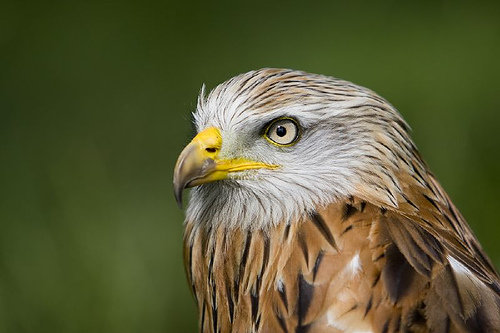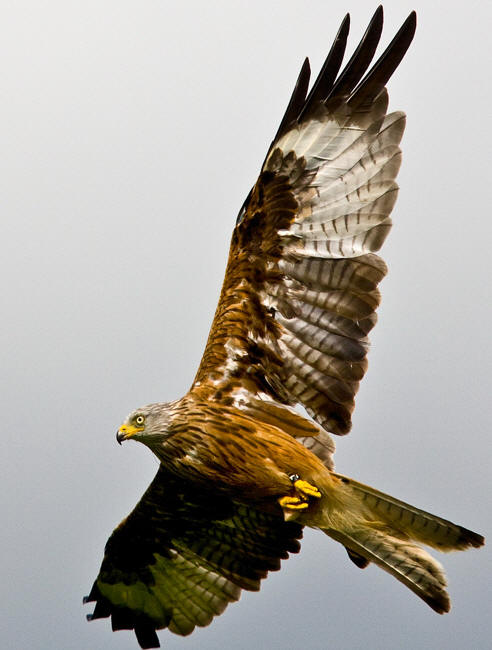Article
Red Kite
Latin Name: Milvus Milvus
Red Kites are a bird of prey and in Medieval
Britain they were a common site on the streets of London, and many other places,
scavenging for food, however this lead to their downfall as they were labelled
as vermin and almost became extinct. Shakespeare is said to have referred to
them no fewer than 15 times. In fact in London they were protected by Royal
Decree because of their ability to remove refuse and dead animals which if left
lying around could have caused diseases. In the |
 |
|
14th and 15th centuries they were |
 By
Brian Scott
By
Brian Scott

|
probably the most numerous of the bird of prey
species in Britain. However by the 16th Century they were considered vermin
and in a parliamentary act aimed at controlling vermin the put the price of
1 old penny on the head of each kite, as a result over the next 200 years
they were slaughtered and numbers dropped considerably. By the 19th century,
the rise of the game keeper and Victorian egg and skin collectors, this was
the final blow for them in England and Scotland. The last recorded breeding
pair being new Ludlow in Shropshire in the mid 1870's and in Scotland in
1884. However a handful of pairs did survive in the remoter valleys of mid
Wales. In 2003 there were
around 625-675 breeding pairs in Britain of this 350-400 in Wales, 220 in
England and only 57 in Scotland. It is now though that UK breeding pairs number
1000+. Today there is a good population
of Red Kites in Wales. None of those in Wales have been deliberately
reintroduced they are all descended from a handful of birds which managed to
survive in the remote valleys of mid-Wales plus the odd immigrant. Although they
are increasingly common around the feeding stations in Mid-Wales, but are still
a rare site in other parts of Wales. However the survival of this Welsh
population has not purely been down to luck, but through efforts of dedicated
enthusiasts who have taken the time to conserve, protect and feed the
populations there. Persecution is still a
major factor in limiting the spread of them to other areas and secondary
poisoning is also not helping. Their numbers in most other parts of their world
range are declining rapidly due to agricultural practices and therefore the
population in Britain is becoming more important.
As a part of this conservation in 2007, 30 Red
Kite Chicks were taken and released in County Wicklow in Ireland. It is hoped
that through more releases up to 2011, when they hope to have released around
250 Welsh Kites that a population in Ireland can be established.
Identification
They have dark chestnut
brown backs and lighter brown under-parts. Their long red tails are forked, they
have black beaks and yellow feet. Tails are deeply forked and grey/white with
black tips. Their most recognisable feature is the white patches on the
undersides of their wings which can be seen when in flight.
|
Animal
Facts
In Britain: All Year
Life Span: Those that reach maturity live
an average of 10 years, the oldest known wild kite was 26 years old.
Statistics: Body length 61-66cm, wingspan 175-195cm and weigh 0.7-1kg
Habitat: Prefer deciduous woodland and
areas with scattered trees, breeds in steep sided valleys with mature woodland,
winters on uplands in open country.
Food: Hunt small birds and mammals, also
feed on carrion and at rubbish tips. They are largely scavengers feeding on dead
animals and meat scraps but invertebrates (worms) are important. When feeding
their young they will take live prey such as frogs, voles, rats, squirrels,
young rabbits and young crows.
Breeding: lay eggs March-May, 1-4 eggs,
incubation 32 days, young fledge after 50-60 days, but continue to be fed by
parents for a further 2-3 weeks. It has been found in the Wales population that
they breed for the first time at 2-3 years of age and usually within 20km of
where they were reared. They usually produce one chick, but at times have been
known to produce 2 or 3.
|
Conservation
Status

Near Threatened
 |
.
|
Distribution: They range across Europe, the middle East and N Africa.
Within Britain they are very common in mid-Wales and appear in small numbers
near their preferred habitat in other areas of the UK. Re-introduced birds can
be found in Buckinghamshire/Oxfordshire border (Chilterns), Northamptonshire and
in Yorkshire north of Leeds. A Scottish population can be found around releases
sites of Dumfries and Galloway, Stirlingshire, West Perthshire and Black Isle in
Ross-shire.
Behaviour: They will gather in large groups at roosts and to feed at good
food sources. They nest in large trees making a platform of sticks built between
the fork of a tree. A pair may have more than one nest. The male fetches the
food, but it is fed to the chicks by the female. They make a mew-like sound with
a long first note that is then rapidly repeated several times.
Conservation Status: In some areas of eastern Europe numbers are not
accurately known, but western European populations are under threat from
persecution and poisoning. In Britain there is a good population of wild birds
in Wales, with the Kite Feeding Station at Gigrin Farm in Powys reporting 500+
birds coming in for food over the winter months. There are also other
re-introduction programmes run by the RSPB including in the Chilterns. It is
thought that there may now be more than 1200 breeding pairs in Britain. Through
this conservation and re-introduction effort many of the birds in Britain are
tagged. |

 by
Simon Greig
by
Simon Greig

|
In Britain in 2008 the following has been noted:-
-
46 breeding pairs in Scotland fledged 82 young.
-
North East England breeding population doubled
from 11 pairs to 23 and they fledged 22 young
-
Yorkshire 67 breeding pairs fledged 115 young
-
Central Scotland 45 breeding pairs fledged 75
young.
-
In Dumfries and Galloway 30 breeding pairs fledged
53 young and a Welsh Red Kite was involved in one of these pairings, the first
confirmed sighting of a Welsh Kite in Scotland.
-
A further 35 birds were released as part of a
reintroduction programme to Aberdeen, Scotland.
 a gallery is available, which links back to this page and a second gallery
features
Girgrin Farm,
a gallery is available, which links back to this page and a second gallery
features
Girgrin Farm,
 the Red Kite Feeding Station in Powys, mid Wales, with images also taken
at the same time.
the Red Kite Feeding Station in Powys, mid Wales, with images also taken
at the same time.
See Also
Red Kite Gallery

Where
to Photograph Red Kites

Gigrin Farm
- Red Kite Feeding Station, Powys

Girgrin Farm Gallery

RSPB details

Where to Watch Red Kites
in the Chilterns

|